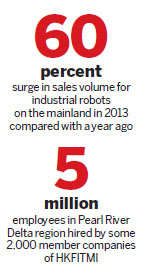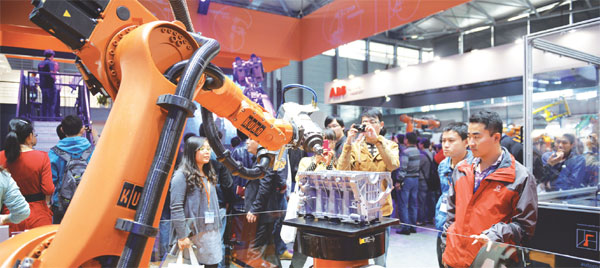It's a world of robots as labor costs mount
Updated: 2014-10-23 07:58
By Zhou Mo in Hong Kong(HK Edition)
|
|||||||||
Cornered by rocketing labor costs and severe labor shortages? Enterprises can take a leaf from small and medium-size manufacturers in Shenzhen which have increasingly turned to robots to do the work of employees.
It may sound a bit worrying for workers, but this could be the future trend if rents and wages continue to climb.
"Last year, we sold more than 2,000 industrial robots - up 30 to 40 percent compared with previous years," said Li Jun, head of sales department at Fujisan Ltd, a Shenzhen-based company specializing in researching and developing industrial robots.
"Labor costs in Shenzhen have already reached a high level. Demographic dividends (of our country) and the number of migrant workers in the city are decreasing year by year. At the same time, the cost of industrial robots is falling. Due to these factors, more and more enterprises are turning to industrial robots in an effort to tackle labor problems," Li told China Daily. It's estimated that Shenzhen now has 200 to 300 robot companies. The output value in the robot and automation industry exceeded 20 billion yuan ($3.3 billion) last year.
For small- and medium-sized enterprises, what they spend on industrial robots is not a small amount. The retail price of an industrial robot ranges from tens of thousands to several million yuan. Although companies could ease their capital pressure by hiring such intelligent equipment instead of buying them, few of them have grown big enough or gained abundant credit to do so.

"We only dare to rent our expensive products to enterprises with a good credit record and reimbursement capability," Li said, adding that the satisfying sales performance of robot companies also leads to a gloomy hiring market. "Some robot companies get a large number of sales orders, so they are too busy to operate hiring business."
Du Zhengzhi, sales director of Fukucima, another robot company in Shenzhen, said that since introducing the service a year ago, the company's hiring business has been limited to its circle of friends. "It's all right renting out robots to small- and medium-sized enterprises. But, for micro-enterprises, we do not dare to do so," said Du, adding there are no standards in the industry to judge the credit performance of some enterprises.
Qiu He, deputy secretary-general of the Shenzhen Robotics Association, said less than 10 enterprises in the city have started robot-hiring business so far.
The demand for industrial robots on the mainland has been growing in recent years. According to the International Federation of Robotics, a total of 36,560 units of industrial robots were sold last year - up almost 60 percent from the previous year.
Sales of industrial robots are expected to rise to about 50,000 units this year. In the next three years, the federation estimates, the figure will grow by at least 25 percent on average annually, reaching approximately 100,000 units by 2017. By that time, more than 400,000 industrial robots would have been installed at factories on the mainland.
According to the latest report from the Shenzhen association, the annual growth rate for the industrial robots industry in the Pearl River Delta region is 30 percent, with some industries reaching 60 percent.
sally@chinadailyhk.com
|
Visitors take a look at robot technology for manufacturing displayed at the 2013 China International Industry Fair in Shanghai. Automation may quench the thirst for labor shortage of small-and medium-sized manufacturing enterprises in the Pearl River Delta region. AFP |
(HK Edition 10/23/2014 page8)
